Attack on Pearl Harbor
![]()
This article discusses the 1941 attack. For the bombing of Pearl Harbor in 1942, see Operation K.
Attack on Pearl Harbor
Part of: World War II, Pacific War
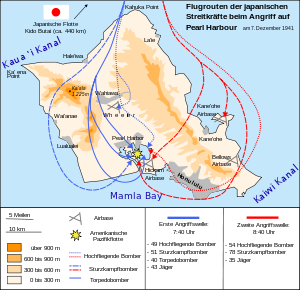
Map of Oʻahu with Japanese approach routes
Overview - Pacific War
Japanese offensives 1941-1942
1941Thailand
- Malay Peninsula - Pearl Harbor - Hong Kong - Philippines - Guam - Wake - Force Z - Borneo
1942
Burma - Rabaul - Singapore - Sumatra - Timor - Australia - Java - Salamaua-Lae - Bougainville/Buka - Indian Ocean - Port Moresby - Coral Sea - Midway - North America - Buna-Gona - Kokoda Track
The attack on Pearl Harbor, also known as the Raid on Pearl Harbor or Operation Ai, was a peacetime surprise attack by the Imperial Japanese Naval Air Forces on the U.S. Pacific Fleet anchored at Pearl Harbor in the Hawaiian Territory on December 7, 1941. The following day, the United States declared war on the Empire of Japan.
With the attack, the Empire of Japan expanded the Pacific War it had been waging since 1937. The operation was intended to temporarily eliminate the U.S. Pacific fleet in order to gain unhindered access to raw materials in Southeast Asia. Following the U.S. declaration of war on December 8, the Nazi German Reich, which was allied with Japan, and Italy subsequently declared war against the United States on December 11, 1941 (Declaration of War by Germany and Italy on the United States). Thus, the attack on Pearl Harbor and its aftermath became a decisive turning point in World War II, for the U.S. declaration of war against Japan and the Axis declaration of war against the U.S. signified the entry of the United States into World War II. Although the U.S. had also provided considerable material support (lend-lease) to Great Britain and the Soviet Union prior to December 11, it had still remained formally neutral.
Much of the U.S. Pacific fleet was disabled by the attack. This was especially due to the fact that the commanders at Pearl Harbor had inadequately prevented surprise attacks.
At the time of the attack, the Pacific Fleet aircraft carriers were not at Pearl Harbor and therefore were not hit. The Japanese had not attacked the fuel depots, shipyards, and docks, which was of benefit to the Americans. A few hours before the attack, the Japanese offensive against the British and Dutch colonies in Southeast Asia had begun (Japanese Invasion of the Malay Peninsula). The attack on Pearl Harbor is considered the battle in the aftermath of which the battleship was replaced as the dominant element of naval warfare by aircraft carriers and, more importantly, aircraft.
Although the attack significantly weakened the U.S. militarily, the long-term consequences for Japan were fatal. The attack, which was perceived as "treacherous" in the U.S., enabled the American government to mobilize the U.S. population, which until then had been largely pacifist or isolationist, in favor of entering the war, which, due to the enormous American industrial potential, brought about the decision in favor of the Allies. To this day, the name Pearl Harbor is synonymous in the U.S. with a devastating attack that took place without any warning.

Attack on the ships lying in the harbor. In the center, an explosion following a torpedo hit on the USS Oklahoma. Two attacking Japanese aircraft can be seen: one over the USS Neosho and one over the Navy Yard (shot from an attacking Japanese aircraft).
U.S.-Japanese relations prior to the attack on Pearl Harbor.
See also: Prehistory of the Second World War in the Pacific Region
Beginning in 1937, Japan waged the Second Sino-Japanese War in China. The United States was initially neutral, but its stance changed in favor of China in the following years because of the Panay Incident and increasing reports of Japanese atrocities, such as the Nanking Massacre. Thus, the U.S. increasingly sided with China. The U.S. was concerned with protecting its own influence and economic interests in Asia. They supplied large quantities of war materials to China. Furthermore, in early 1940, the U.S. warned Japan not to invade French Indochina and demonstratively moved its Pacific fleet from its home base in San Diego on the West Coast to Pearl Harbor in the Hawaiian Islands. When Japan deployed troops in Indochina in July 1940 despite U.S. warnings, the U.S. government under President Franklin D. Roosevelt in September 1940 restricted U.S. exports of oil and steel to Japan (at the time, Japan obtained 80% of its oil from the United States). When this did not have the desired effect and Japan occupied French Indochina with 40,000 troops on July 24, 1941, after some pressure on the Vichy regime, the situation had worsened. Now Japan could cut off supplies to China and had a clear path to the oil wells in the Dutch Indies. As a result, on July 25, 1941, the United States imposed a complete oil embargo on Japan and froze all Japanese assets. With Britain and the Netherlands Indies joining in this move, Japan lost 75% of its foreign trade and 90% of its oil imports.
Without oil imports, Japan's reserves for industry and the military would only last for a few months, so the Japanese leadership under Prime Minister Hideki Tōjō had to restore oil supplies within that time if it wanted to prevent the collapse of the empire. It saw only two ways to do this:
- either Japan achieved a lifting of the embargo through negotiations with Washington in return for Japanese concessions,
- or Japan forcibly secured its supply of oil and other scarce resources by seizing the resource-rich Southeast Asian colonies of Britain and the Netherlands.
The majority of Japan's leadership believed that an agreement with the U.S., on terms acceptable to Japan, was unlikely. Moreover, even if an agreement were reached, Japan would remain dependent on foreign raw materials. The consequences of this dependence were acute. Japan nevertheless entered into negotiations with the U.S. government, which eventually resulted in the Hull Note on November 26, 1941. This was taken as an ultimatum by Prime Minister Tōjō and the Japanese cabinet.
Meanwhile, the military was preparing to attack the British and Dutch colonies in the south. From Japan's point of view, the opportunity was favorable because the Netherlands had no significant forces and Britain's forces were tied up because of the war in Europe. Moreover, the Automedon incident had put Japan in possession of the British General Staff's top-secret strategic directives for the Far East. These contained not only a detailed analysis of existing British forces in Asia and planned strategies in the event of war, but also the particularly valuable information as to the extent to which Britain was willing to transfer forces from other fronts to Asia. As a result, the Japanese high command was better informed about British vulnerability than most British commanders.
However, between Japan and the raw materials to be conquered still lay the Philippines, which at that time was a semi-autonomous colony of the USA. From there, the U.S. would have been able to disrupt the transportation routes between raw materials in Southeast Asia and Japanese industry in the event of a war with Japan. U.S. entry into war as a result of Japanese aggression in Southeast Asia was extremely unlikely due to the isolationism and pacifism prevalent in the American population, but many Japanese military officials felt that conflict was ultimately inevitable due to U.S. policy in previous years and therefore called for the occupation of the Philippines as part of the offensive. They pointed out that both the Philippines and other U.S. possessions located in the Western Pacific, such as Guam and Wake, were weakly defended (for example, the U.S. Navy's Asian fleet had only three cruisers and 13 obsolete destroyers), but that this could change quickly. Furthermore, after the outbreak of war in Europe, the U.S. had begun a massive expansion of its fleet, which included ten South Dakota and Iowa class battleships and nine large Essex class aircraft carriers. These units under construction alone formed a fleet stronger than the entire Japanese fleet built in 30 years. Further, in 1941 Japan could hope that the war in Europe would tie up some of its American resources. At a later date, it would have to fight alone.
In contrast, there was a smaller group of officers and politicians who warned against war with the USA. They pointed to the enormous industrial capacity of the U.S., which not only built this huge fleet but at the same time produced huge quantities of armaments for Great Britain and the Soviet Union (cf. Lend-Lease Act), without this leading to restrictions in the production of civilian consumer goods. For example, some 4.5 million trucks had been built in the United States in 1940, while only 48,000 had been built in Japan. One of the most prominent opponents of a war with the United States was originally Admiral Yamamoto Isoroku, Commander-in-Chief of the Combined Fleet and former Japanese naval attaché in Washington. On the prospect of winning such a war, he said, "If I get orders to wage war regardless of the consequences, I will lash out wildly for 6 months or 1 year. But should the war last a second or third year, I see extremely black!". No one believed that the war could be won within a year. Nevertheless, the Japanese leadership finally decided to go to war against the United States at the end of November 1941. Yamamoto was nevertheless the one who, against opposition, succeeded in launching an annihilation strike against the Pacific Fleet in order to gain time for the conquest of territories in Southeast Asia.
In Washington, diplomatic negotiations continued, for the sake of appearances, until the morning of 7 December. On December 6, Tokyo began transmitting to the Japanese Embassy in Washington a note in 14 parts to be delivered to the U.S. Secretary of State at 1:00 p.m. Washington time sharp (30 minutes before the planned start of the attack). With this note, Japan officially informed the U.S. that, due to the attitude of the U.S. government, it saw no point in further negotiations and was therefore breaking them off. However, contrary to widespread opinion today, the note did not contain a declaration of war by Japan. The decisive 14th part, which contained the breaking off of negotiations, was not sent until the night of December 7. Although the note had already been translated into English by Tokyo and only needed to be deciphered, it took too long to prepare. This was due in large part to the fact that the overtired embassy employee, who had to retype the text after decryption, made so many typing errors at the beginning that he finally decided to throw away the first pages and rewrite them again. But even the decryption took longer than Tokyo expected. As a result, the grade was not delivered until several hours after the attack.
The US Pacific Fleet
In the prewar period, the Pacific Fleet had always been considerably stronger than the Atlantic Fleet. Under the Washington Naval Treaty of 1922, the U.S. was allowed to possess 15 battleships and six aircraft carriers; of these, twelve battleships and four carriers were assigned to the Pacific Fleet. These were also the most powerful ships; the three battleships of the Atlantic Fleet (Arkansas, New York, Texas) were the oldest in the fleet. The reason for this lopsided distribution was that in the Pacific, Japan, a potential enemy, had the third largest fleet in the world, while the largest fleets in the Atlantic belonged to Great Britain and France, with whom no conflicts were expected.
This changed when, with the defeat of France in 1940, the French fleet was neutralized and the Royal Navy had to fight alone in the Atlantic and Mediterranean against the German and Italian fleets.
To relieve Great Britain as much as possible in the process, the U.S. extended its neutrality patrol further and further into the Atlantic. Thus, American cruisers monitored the Denmark Strait and American destroyers escorted convoys in the western Atlantic until they were taken over by British destroyers for the most dangerous part of the way. To this end, a quarter of the Pacific Fleet was transferred to the Atlantic, including the battleships New Mexico, Mississippi, Idaho, and the aircraft carrier Yorktown. Further, almost all newly built aircraft were either deployed in the Atlantic or delivered directly to Great Britain under the Lend-Lease Act; American forces in the Pacific had to make do with what they had.
Nevertheless, the Pacific Fleet was quite strong by the standards in effect up to that time, which still assumed a battle decision by battleships. It had nine battleships with a total of 24 guns of 406 mm (16 inch) caliber and 68 guns of 356 mm (14 inch) caliber against ten Japanese battleships with a total of 16 guns of 406 mm (16 inch) caliber and 80 guns of 356 mm (14 inch) caliber.
The core of the battle fleet was formed by the big five, the five battleships of the Tennessee and Colorado classes. These battleships, built only after World War I, were the most powerful of the fleet between the world wars. In terms of their artillery and armor, they were still on a par in 1941 with the most modern battleships in the world at the time, such as the British King George V class or the German Tirpitz. Only in terms of speed were they now inferior to the modern battleships, with their relatively slow 22 knots. However, since the Japanese fleet itself also consisted of battleships built during or immediately after World War I, this disadvantage did not come into play in the Pacific.
For aircraft carriers, there was a ratio of three American to ten Japanese (including four smaller carriers), but the role of the carriers was seen more as supporting the battleships with air reconnaissance.
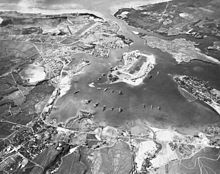
Pearl Harbor in October 1941, with Ford Island in the center and Battleship Row to the left.
Preparations
U.S. planning for war against Japan had long been based on War Plan Orange, under which the U.S. Pacific Fleet would, in the event of war, run from its home base in San Diego to the Philippines to defend it against a Japanese attack and then use it as a base for an advance against Japan itself. In the course of these operations, there would then be a major decisive battle between the battleships. The possibility of opening the war by a Japanese surprise attack similar to the attack on Port Arthur at the beginning of the Russo-Japanese War in 1904 was considered quite possible. However, an attack on Manila, the base of the weak U.S. Asian Fleet, or Wake Island was thought to be possible. The U.S. Pacific Fleet, however, was located at its home base in San Diego, far outside the operational range of the Japanese fleet.
With the transfer of the Pacific Fleet to Pearl Harbor in 1940, this changed - Pearl Harbor was just within the area in which Japanese fleet units could operate with reasonable effort. Outward and return trips could be accomplished with a single refueling at sea. When Japan began planning for an attack, however, difficulties were quickly encountered. The topographical shape of the harbor, virtually an inland body of water connected to the sea only by a natural channel, made a torpedo attack with destroyers, such as had been made at Port Arthur in 1904, impossible. The destroyers would first have had to run through the channel into the harbor to get a clear field of fire for their torpedoes. In doing so, they were bound to be spotted and shot up.
An air attack was explored as an alternative. Again, this was not an entirely new idea: during a joint U.S. Army-Navy exercise to defend Hawaii in 1932, Admiral Harry E. Yarnell, commander of the attacking forces, had the squadrons of the aircraft carriers Saratoga and Lexington fly an attack on Hawaii. This attack, conducted from a northwesterly direction on February 7, 1932 (as December 7, 1941, was a Sunday), inflicted considerable damage on the surprised defenders, according to the arbiters. It is quite possible that this maneuver also influenced Japanese planning, although the American Navy rejected the results as unrealistic at the time.
However, the template for the attack was provided by the British in the Mediterranean when they attacked the Italian naval port of Taranto with torpedo bombers from the aircraft carrier Illustrious on the night of November 11-12, 1940, sinking three Italian battleships. This attack was intensively studied by both the Japanese and U.S. admiral staffs, as conditions at Taranto were very similar to those at Pearl Harbor, particularly with regard to the use of torpedoes. The use of torpedoes was absolutely necessary, according to the planners, since this was the only weapon with which aircraft could attack battleships with any chance of success.
The available bombs, on the other hand, were generally believed to be incapable of penetrating the massive deck armor of battleships and inflicting major damage. However, because the weight of torpedoes dropped by aircraft caused them to sink to a greater depth before the built-in depth control system steered them back up, shallow ports such as Taranto and Pearl Harbor were considered safe. To prevent the torpedoes from hitting the bottom and getting stuck in port, the torpedoes had been modified with small wings so that they would remain in a horizontal position longer after being dropped, rather than dipping into the water at an angle that increased with the drop height, as was usually the case. In addition, the British pilots had flown extremely slow and low. The Americans received this information from the British. Japanese officers were able to view a recovered British torpedo at Taranto.
The U.S. Navy revised its guidelines regarding torpedo protection of ships in port as a result of the attack. Until then, a water depth of 76 feet (23 meters) was considered the minimum for a successful torpedo attack from the air. In June 1941, with reference to the attack on Taranto, this was corrected to the effect that torpedo attacks were also possible at shallower water depths. However, attacks at a water depth of less than 20 meters were considered unlikely, so Pearl Harbor was still considered safe at an average water depth of 15 meters. The Americans also believed that a similar attack on Pearl Harbor would be unlikely because the distance between Taranto and the British base at Alexandria was much less than that between Pearl Harbor and the nearest Japanese bases. The undetected approach of an enemy was therefore considerably more difficult. In addition, the Japanese Nakajima B5N Kate torpedo bombers could not fly as slowly as the old Fairey Swordfish-type biplanes of the British, which they felt precluded the use of the British method. The Americans assumed the range of the aircraft available to them (350 km radius of action) and significantly underestimated the range of the Japanese aircraft (1000 km radius of action).
The Japanese, on the other hand, concluded that a torpedo attack would be feasible if torpedoes were modified accordingly. This led to the development of the Type 95 torpedo, which was smaller and lighter than the usual Japanese torpedoes. In addition, armor-piercing shells of 356 mm and 406 mm caliber were modified so that they could be dropped as bombs. Dropped from an altitude of at least 3,000 meters, they were intended to have sufficient penetrating power to penetrate the armor of battleships. It was one of these armor-piercing bombs that hit the Arizona's ammunition compartment.
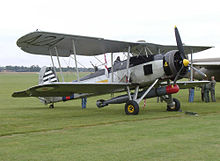
Fairey Swordfish type torpedo bomber
The plan
The plan according to Admiral Yamamoto's quote:
"At the outset of the war the battle group, consisting of six aircraft carriers as a nucleus and commanded by the Commander-in-Chief of the 1st Air Fleet, is to continue on its way to the Hawaiian Islands and attack from the air the main forces of the U.S. fleet anchored in the harbor. The task force will consequently sail from the homeland about two weeks before the outbreak of hostilities, approach the Hawaiian Islands from the north, and launch all aircraft aboard the carriers, about 400, an hour or two before daybreak. The surprise attack on the anchored enemy carriers and ships, as well as aircraft on the ground, will be launched from a point about 200 nm north of Oʻahu Island.
The submarine force, consisting of 27 submarines and commanded by the Commander-in-Chief of the 6th Fleet, will continually reconnoiter the movement of the enemy fleet anchored in Hawaii and begin these operations several days before the opening of hostilities. In the event the enemy fleet leaves port, the submarine force will launch a surprise attack or attempt to maintain contact with it. On the other hand, the special attack force will be subordinated to the submarine force, which will advance undetected into Pearl Harbor and launch a surprise attack on the enemy fleet simultaneously with the air attacks of the strike force."
According to the Japanese attack plan, the aircraft carrier convoy was to approach Pearl Harbor undetected on a route of about 6,000 kilometers north of the usual shipping lanes in a voyage of eleven days and attack by surprise from a distance of 350 kilometers north of the base. Since most U.S. armed services operated with reduced personnel on Sundays, the date chosen for the attack was the first Sunday in December, December 7. The attack was to be carried out by the Kidō Butai, consisting of the six aircraft carriers Akagi, Kaga, Hiryū, Sōryū, Zuikaku, and Shōkaku. The escort of the carriers consisted of the fast battleships Hiei and Kirishima, the heavy cruisers Tone and Chikuma, and 9 destroyers led by the light cruiser Nagara.
The main strategic targets of the attack were:
- Neutralization of the Pacific Fleet: By eliminating battleships and aircraft carriers, the American fleet should not be able to hinder the Japanese offensive in Southeast Asia. Attacking pilots were given explicit orders to attack only battleships and carriers and not to "waste" their torpedoes and bombs on other ships (not all complied with the order during the attack).
- Elimination of Pearl Harbor base: Destruction of the dock facilities and fuel tanks was intended to make it impossible for the U.S. to operate from Pearl Harbor for the foreseeable future. The docks at Pearl Harbor were the only facilities west of California where repairs and major maintenance could be performed. If they were destroyed, American ships would have to travel halfway across the Pacific to the West Coast even for minor repairs. Ideally, the sinking of a large ship in the approach channel would even eliminate Pearl Harbor as an anchorage, requiring the entire fleet to first approach from the West Coast for any operation.
For tactical reasons, another target was added:
- Destruction of air forces: the American airfields had to be attacked so that the fighters stationed there would not interfere with the attacks on the harbor and the bombers would not fly counterattacks on the attack force (if it could be located).
Since there were not enough aircraft to accomplish all three tasks simultaneously, it was decided to attack only the ships and the airfields first. As soon as the planes returned, they were to be refueled and re-munitioned to attack the docks and fuel tanks.
The first attack was to be made as early as possible at dawn. Since the carriers of that time did not use catapults, half the deck was always needed as a runway. This meant that only half of the planes could be brought on deck for takeoff at the same time. The second half could only be made ready for takeoff after the first half had taken off. Since launch preparations took at least 30 minutes, it was decided to fly the first attack in two waves: the first half flew ahead, the second followed as fast as they could be cleared for takeoff.
The first wave was to consist of 45 A6MZero fighters, 54 D3AVal dive bombers and 90 B5N Kate torpedo bombers. 40 of the Kate were to carry torpedoes, the rest bombs. The second wave was to consist of 36 Zeros, 81 Val and 54 Kate (all carrying bombs).
Since surprise was elemental in this attack, the commander of the attack force, Vice Admiral Nagumo Chūichi, had orders to turn back immediately if he was discovered on the approach. If he was not discovered until the morning of the day of the attack, it was up to him whether he wanted to risk the attack. In no case should he expose his ships to unnecessary risk, as they were irreplaceable to Japan.
The attack force departed Japan from waters in the Kuril Islands on November 26, 1941. While underway, Admiral Yamamoto sent a coded message to Nagumo on December 2: Niitaka yama Nobore (Climb Mount Niitaka), giving the final order to carry out the attack.

Japanese dive bomber Aichi D3A Val
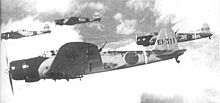
Japanese torpedo bomber Nakajima B5N Kate
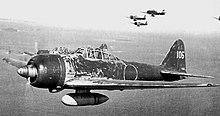
Japanese fighter type Mitsubishi A6M Zero
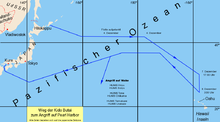
Path of the Kidō Butai to the Attack on Pearl Harbor
Japanese espionage
The Japanese spy Takeo Yoshikawa had come to Honolulu in March 1941. Disguised as an employee of the Consulate General, he had entered officially. Since more than a third of the population in Hawaii was of Japanese descent, Yoshikawa had no problem posing as a native. Yoshikawa knew exactly when which capital ships were in port and the frequency of their sailings. He knew details of the rosters of military installations and knew that the main airport, Hickham Air Field, had no significant air defenses. During the first months of his assignment, Yoshikawa sent a report on the status of the U.S. fleet in Hawaii once a month, twice a week beginning in mid-November, and daily beginning on 2 December 1941. In this, Yoshikawa received help from the Japanese consul in Honolulu, Nagao Kita.
His reports were encrypted with the cipher system of the Japanese diplomatic service. Although this could in principle be cracked by the cryptanalysts of the U.S. War Department, a suitable decryption would still have had to be found for each day and for each place of origin of a message. Most of the telegrams sent by Kita were not decrypted by the other side until it was far too late.
The German couple Bernard and Friedel Kühn, together with their daughter Ruth, gathered information on the island and sent it to Tokyo via the consulate. They became Japanese agents in 1936 at the suggestion of the Nazi state. With forged papers, they came to Hawaii disguised as a professorial family. Ruth maintained contact with American officers there and obtained secret information. The Kühns built a house in Pearl Harbor overlooking the U.S. naval base on behalf of the Japanese.

Bernard Kuehn, FBI photo 1941
The American radio reconnaissance
American telecommunications reconnaissance was divided into three work areas:
- Radio direction finding was responsible for locating the senders of intercepted radio messages. For this purpose, the USA had set up a network of listening stations, the Mid-Pacific Strategic Direction-Finder Net. It extended in a huge semicircle from the Philippines through Guam, Samoa, Midway and Hawaii all the way up to Alaska.
- In the radio traffic analysis section, the patterns of the intercepted radio transmissions were analyzed. The call signs were used to determine who was talking to whom. From the frequency of communication, they tried to figure out the relationship between stations. For example, if NOTA 1 and OYO 5 stations spoke frequently to KUNA 2 but rarely to each other and not at all to others, it could be assumed that KUNA 2 was the commander of NOTA 1 and OYO 5, such as the flagship of a squadron to which NOTA 1 and OYO 5 ships were assigned. With the help of radio direction finding, the assignment of call signs was possible if one knew which units/ships were at the transmitting position at the time of transmission.
- The cryptanalysis section was responsible for deciphering the intercepted messages. This was the most difficult and secret part of radio reconnaissance. Since it was extremely important to keep secret the fact that it had been possible to break the Japanese code, the information obtained from it was made available only to a small group of senior officers and politicians, while the results of radio direction finding and radio traffic analysis were available to a much wider circle. For example, the commanders in Hawaiʻi, Admiral Husband E. Kimmel and General Walter C. Short, received the results from radio direction finding and radio traffic analysis, but not those from cryptanalysis, while the commander in the Philippines, General Douglas MacArthur, had access to all information.
During November 1941, radio reconnaissance detected preparations for a major operation based on Japanese radio patterns. These patterns corresponded to the three phases already observed in the preparations for the two operations to occupy Indochina.
- First phase: There was a surge in radio traffic. The high command issued orders and instructions for the operation to the army and fleet commanders. These instructions were relayed throughout the hierarchy to the units that had to prepare for the operation. In this way, it was often possible to already identify the units involved by checking which call signs were involved in the increased radio traffic. However, since the Japanese fleet had conducted its semiannual callsign change for its 20,000 callsigns on November 1, many callsigns had not yet been re-identified. However, it was noted that the Japanese high command communicated mainly with southern commanders but not with commanders in China.
- Second phase: radio traffic dropped back to the normal amount of messages. The units involved had prepared according to the instructions and were waiting for the order to begin operations. Changes could be seen in the radio patterns that had resulted from regrouping. Stations were suddenly communicating with new stations, but not with their previous communication partners.
- Third phase: The number of radio messages rapidly decreased and became one-sided. The operation had begun, the fleet units had moved out and were maintaining radio silence to prevent bearing on their position. However, they continued to receive radio messages addressed to them from other units (thus, the radio silence affected only the transmission, not the reception of the operational units).
On December 1, the Japanese fleet changed call signs again. This unscheduled change further alarmed the intelligence community.
In this way, based on radio direction finding and radio traffic analysis alone, it was known that Japan was going to conduct a major operation to the south. However, the objective was not clear; it could be an attack on the British and Dutch colonies (which was suspected), as well as an attack on the Philippines or further troop deployments to Indochina (which was considered unlikely). On November 24 and 27, therefore, the Chief of Naval Operations, Admiral Harold R. Stark, sent war warnings to all commanders in the Pacific, informing them that aggressive action by Japan could be expected in the next few days. Malaysia, Thailand, the Philippines, Borneo, and Guam were mentioned as possible targets of a Japanese attack. All commanders in the Pacific were instructed to take appropriate measures to prepare their forces for war, but not to take offensive action themselves until Japan took overt war action against the United States.
The intelligence services of Great Britain and the Netherlands, which cooperated with the Americans in intercepting and analyzing the messages, had the same picture. Britain then began to reinforce its forces in the area of possibility: it moved the modern battleship Prince of Wales and the battlecruiser Repulse to Singapore.
The Japanese carrier units were a special case. Nothing was known about them, since there was total radio silence. The fact that the carrier units not only did not send any messages, but also that no messages were sent to them, led to the assumption that the carriers were still in the Japanese home waters. There, they were able to communicate via weaker short-range transmitters whose transmission power was too weak to be received by the distant listening stations. This blackout had been observed in previous operations. At that time, too, the carriers had been suspected to be in Japan, and it had later been determined by various means that they had indeed been there. The carriers' suspected remaining in Japan did not arouse suspicion because it fit perfectly into the overall picture. According to analysts, the carriers were not needed for an offensive alone against the British and Dutch colonies; instead, together with several battleships, they formed a strategic reserve in case the United States came to Britain's aid. In fact, however, the unit was on its way to Pearl Harbor under radio silence. Messages to it were hidden in general radio messages addressed to large areas of the fleet.
In the meantime, the department responsible for cryptanalysis was experiencing major problems with the volume of intercepted material. In addition to decoding the messages, it had to be translated from Japanese into English. The small number of translators, who were responsible not only for military but also for diplomatic traffic, could no longer keep up with the significantly increased volume. Attempts were made to increase the number, but this was difficult. The translators not only had to be excellent in Japanese, but also absolutely trustworthy. Such people were few and far between, and they were largely Americans of Japanese descent, who were generally distrusted. Thus, in 1941, despite its best efforts, the Naval Cryptanalysis Division succeeded only in doubling the number of translators from three to six. As a result, translations were ranked by type of cipher. First came diplomatic traffic encrypted with the "Purple" key machine, then traffic encrypted with high-security military codes, then texts encrypted with simpler Japanese codes. In this way, Purple-encrypted instructions were transmitted to the Japanese embassies in Britain and the Dutch East Indies to return their "Purple" machines to Japan and prepare to destroy their remaining codes. This confirmed the suspicion of an impending war with these countries. However, instructions to this effect to consulates in the U.S., which had no "Purple" machines, were not translated. The only "Purple" machines within the U.S. were at the Japanese Embassy in Washington, where they were still needed. The fact that there was initially no order to send these machines back to Japan was interpreted to mean that no attack on the U.S. was planned. It was not until December 3 that the embassy in Washington received orders to destroy one of its two key machines and much of its code, making the possibility of war between the U.S. and Japan considerably more likely for analysts.
The decrypted military messages did not contain anything helpful to identify the targets in more detail. Nor had this been expected. On December 6, the first 13 parts of the 14-part Japanese note, which was to be delivered on December 7, were received and decrypted. Although the 14th part containing the most important information was still missing (the first 13 parts contained mostly a historical outline of U.S.-Japan relations, accusing the United States of a hostile attitude toward Japan, but nothing about intended Japanese policy), the 13 parts already received were taken that evening to all persons authorized to see this secret information. After reviewing the contents, President Roosevelt told his advisor Harry Hopkins, "This means war." After briefly discussing the Japanese fleet and troop movements in Southeast Asia, of which they were aware, Hopkins said he would prefer that the United States strike first and thus forestall any surprises. Roosevelt countered that such a thing could not be done as a peace-loving democracy. Roosevelt wanted to telephone Admiral Stark, but he was in the theater. Calling him out there was possible, but would have caused a stir, which the president wanted to avoid.
All other persons who received the first 13 parts in the evening wanted to wait for the 14th part before initiating action. Secretary of the Navy Frank Knox arranged a conference with Secretary of War Henry L. Stimson and Secretary of State Cordell Hull for the next morning for this purpose. Even Admiral Stark, who did not learn of the existence of the Japanese note until late that evening from the Chief of Naval Intelligence, merely ordered the complete note to be brought to his office the next morning. The Army Chief of Staff, General George C. Marshall, did not get to see the note because he was already asleep and they did not want to wake him. The next morning he went for a ride after breakfast and therefore was not to be found for some time when they tried to bring him the 14th part.
The instruction to the Japanese Embassy in Washington to destroy its remaining codes and the second key machine came with the accompanying text to the 14th part of the Japanese note of 7 December, which included instructions to deliver the note at 1:00 p.m. sharp Washington local time (07:30 a.m. at Pearl Harbor). The translation of the accompanying text reached the intelligence officer in charge, Lieutenant Commander Alwin D. Kramer at 10:20 a.m. Washington time, nearly three hours before the attack on Pearl Harbor began. He immediately relayed the message, and at about 11:30 a.m. General Marshall ordered all overseas commanders to be warned of possible Japanese action, with the Philippines as the highest priority. However, this message did not reach Pearl Harbor in time. It also did not have much effect in the Philippines and other bases in the Pacific such as Wake and Guam, because the time remaining before the Japanese attack began was too short.

The Japanese key machine "PURPLE
Pearl Harbor on December 7
Since a Japanese attack was not seriously expected in Hawaii, the battleships' berths around Ford Island were not secured. For the most part, the crews had shore leave. The fires under the boilers of the ships were either fully extinguished or half extinguished. Without fires under the boilers, the ships could not generate steam for their engines, and firing up a boiler took several hours to build up sufficient steam pressure.
The defense of the island itself was the responsibility of the U.S. Army. Again, the troops were in no way prepared for an attack. The anti-aircraft guns were not distributed around the military installations, but stood in depots, since the surrounding properties were private property whose owners one did not want to annoy unnecessarily. For example, the Army flak at the newly built Kāneʻohe Naval Air Station had been moved back to the barracks a few days earlier. The flak ammunition was stored in separate ammunition depots, and these were locked like all other ammunition depots. In some instances during the attack, key holders reportedly refused to open the ammunition dumps without written orders. On General Short's instructions, all aircraft on the airfields had been moved from their usual positions at the edge of the field and in the dugouts to the center of the field, since this gave them better protection against sabotage. The six new mobile radar stations, which had only arrived in the Hawaiian Territory in October 1941, operated only between 4:00 am and 7:00 am. The decision not to use radar around the clock, but only at the most likely time of attack, was due in part to the skepticism that still surrounded this new technology despite its successful use in the Battle of Britain. However, the fact that the period between 4:00 a.m. and 7:00 a.m. was considered the most probable time for an attack also showed that people were aware of the possibility of an attack and assumed (quite correctly) that such an attack would occur at the earliest possible time after sunrise. Thus, a Japanese attack was not considered impossible, but extremely unlikely based on the current assessment of the situation.
Marine units at Pearl Harbor:
- Battleships
Nevada, Oklahoma, Pennsylvania, Arizona, Tennessee, California, Maryland, West Virginia
With the exception of the Pennsylvania, which was in dry dock, the battleships were anchored in a row off Ford Island in the center of the harbor (Battleship Row). The ninth battleship of the Pacific Fleet, the Colorado, was at Bremerton, where she was being refitted at Puget Sound Naval Shipyard.
- Aircraft carrier
None.
The aircraft carrier Enterprise was scheduled to arrive on 6 December; it had been carrying a squadron of fighters to Wake Island with three cruisers and nine destroyers (a not unusual task for an aircraft carrier at the time). However, the carrier had to run through a storm en route, resulting in a 24-hour delay and an arrival not until the afternoon of the 7th. The Lexington transported another fighter squadron to Midway with three cruisers and five destroyers. However, since the transfer of the two squadrons was to be kept secret if possible, the carriers were officially on training missions. In part, this cover story has persisted to this day; quite a few articles and books still state that the carriers left port for practice shortly before the attack (the Lexington left on December 5). However, prior to that, at least for the Enterprise, it had actually been planned to participate in an exercise with the First Battleship Division (Arizona, Nevada, and Oklahoma) during that period. The exercise then took place without them, and the battleships returned to Pearl Harbor on 5 December.
The last of the Pacific Fleet's three carriers, the Saratoga, was en route to San Diego after a shipyard stop in Bremerton.
- Cruiser
Raleigh, Detroit, Phoenix, Honolulu, St. Louis, Helena, New Orleans, San Francisco
- Destroyer
Ward (outside port), Helm, Phelps, MacDonough, Worden, Dewey, Hull, Monaghan, Farragut, Dale, Aylwin, Henley, Patterson, Ralph Talbot, Selfridge, Case, Tucker, Reid, Conyngham, Blue, Allen, Chew, Shaw, Downes, Cassin, Mugford, Jarvis, Schley, Cummings, Bagley
- Submarines
Narwhal, Dolphin, Cachalot, Tautog
- Minelayer
Oglala, Gamble, Ramsay, Montgomery, Breese, Tracy, Preble, Sicard, Pruitt
- Minesweeper
Zane, Wasmuth, Trever, Perry, Turkey, Bobolink, Rail, Tern, Grebe, Vireo, Cockatoo, Crossbill, Condor, Reedbird
- Gunboats
Sacramento
- Speedboats
PT-20, PT-21, PT-22, PT-23, PT-24, PT-25; on the quay were PT-26 and PT-28; on the deck of the tanker Ramapo PT-27, PT-29, PT-30 and PT-42.
- Destroyer tender
Dobbin, Whitney
- Seaplane tender
Curtiss, Tangier, Avocet, Swan (in dock), Hulbert, Thornton
- Ammunition ships
Pyro
- Tanker
Ramapo, Neosho
- Workshop ships
Medusa, Vestal, Rigel
- Submarine tender
Pelias
- Submarine rescue ship
Widgeon
- Hospital ships
Solace
- Cargo ships
Vega (in Honolulu), Castor, Antares (entering Pearl Harbor)
- Tractor
Ontario, Sunnadin, Keosanqua (off Pearl Harbor), Navajo (18 km outside Pearl Harbor).
- Auxiliary vessels
Utah, Argonne, Sumner
The Japanese High Command was aware of the ships in port because the Japanese consulate in Hawaiʻi continuously reported its observations of the harbor to Tokyo (such observations were a standard part of the consulates of all countries). From Tokyo, the reports were relayed to the fleet (and thus Nagumo). This ensured (within the realm of possibility) that the Pacific Fleet was at Pearl Harbor and that Nagumo was not attacking an empty port. However, both Nagumo and the Japanese high command knew 24 hours before the attack that no aircraft carriers were on the scene.
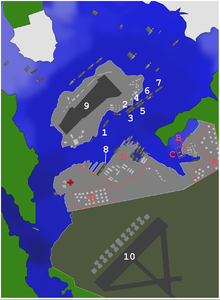
Onshore facilities: City Army Base Marine baseWater depths : <6,5 m ~9 m ~10 m ~11 m ~12 m > 15 maneuvered targets:1: USS California2 : USS Maryland3 : USS Oklahoma4 : USS Tennessee5 : USS West Virginia6 : USS Arizona7: USS Nevada8: USS Pennsylvania9: Ford Island NAS10: Hickam Fieldemphasized targets: A: Oil tanksB: CINCPAC HeadquartersC: Submarine baseD: Naval shipyard.
The attack
Preparations
On the evening of December 6, the inbound Kidō Butai reduced her speed to about 25 knots. Vice Admiral Nagumo sent a final broadcast from the Akagi to all his units. Saying, "The fate of the empire depends on this operation. Every man must give himself totally to his special task," he once again swore in the ship's crews and especially the crews of the aircraft squadrons that were to fly the attack.
By 9 p.m., the fleet had reached the 158th meridian and was still about 910 kilometers north of Hawaii. Fierce winds had torn the hoisted flags during the twelve-day voyage and more than ten sailors had been washed overboard. But everything was going according to plan, as the fleet had not yet been sighted by other ships or reconnaissance aircraft.
Approach
The first Japanese attack wave of 183 aircraft took off at 06:10 local time on the morning of December 7, 1941, about 230 nautical miles (400 kilometers) north of Oʻahu. However, it took 20 minutes longer than planned to form up over the carriers. Six aircraft that had not launched on time remained behind and launched an hour later with the second wave. The crews of the carriers bade farewell to the launching planes with banzai calls. At the same time, 18 SBDDauntless took off from the U.S. aircraft carrier Enterprise, which was about 370 miles west of Pearl Harbor, to fly ahead to Ford Island.
The first clash between the forces of Japan and the United States occurred at 06:37 local time off the harbor entrance. During the night, a periscope had already been seen near the harbor entrance from aboard the minesweeper Condor, and the destroyer Ward, patrolling in front of the harbor entrance, had been alerted. However, the latter could not find a submarine. Then, at about 06:30, the supply ship Antares also reported sighting a submarine, whereupon the Navy launched a PBY Catalina flying boat to assist the Ward. Around 06:45, the Ward found and sank the submarine with gunfire and depth charges. It was one of five Japanese small submarines of the Special Submarine Unit that were to attempt to enter the harbor. A few minutes later, the Catalina reported the sinking of another submarine off the harbor entrance. The Ward's commander, Lieutenant Outerbridge, who had taken over the Ward as his first command only two days earlier, sent a coded message to the commander of the 14th Naval District to inform him that he was fighting a submarine in the harbor defense zone. Delayed by the routine decryption process (including text rewording to prevent plaintext falling into the wrong hands from being used to break into the code in use), the message reached the duty officers at about 07:15 and was relayed from there to Admiral Kimmel. However, in light of numerous false submarine messages in previous weeks, Kimmel wanted to wait for confirmation of the message before taking action.
At 07:02, the two radar observers at the Opanah Radar Station detected a group of 50 or more aircraft 130 miles away approaching from the north. The Opanah radar station was one of six of the Army's new mobile radar units that had been deployed to Oʻahu for less than a month. They were SCR-270 units, a longer-range variant of the SCR-268 series. After a brief discussion, they called the information center at Fort Shafter and reported the location of approaching aircraft, but without mentioning the number of aircraft located. The report was received by a lieutenant who was on duty at the information center for only the second time and did not inquire further. He knew that a group of B-17Flying Fortress bombers was expected and believed that these aircraft had been located. However, since he was not allowed to share this classified information with the radar observers, he simply told them to go off duty (the radar was only ever in operation between 4 and 7 a.m.) and not to worry about the planes ("Don't worry about it.").
First attack
The first Japanese attack wave reached Pearl Harbor without encountering any resistance. On the way, it had shot down several American planes. At least one of these planes still managed to send a radio message, but its content was difficult to understand. At 07:49, the commander of the attack wave, Captain Fuchida Mitsuo, ordered the attack to be carried out in the complete surprise variant, with the torpedo bombers first. His radio operator then transmitted the appropriate signal three times, consisting of to for totsugeki (attack) and ra for raigeki (lightning)(lightning/surprise attack). The signal to ra, to ra, to ra was also received on the carrier unit, which thus knew that the surprise had succeeded. American radio operators also heard it, but they understood tora, the Japanese word for Tiger. This led to the radio message becoming known as Tora, tora, tora.
The attack on the harbor began at 07:55 with the bombing of Ford Island. Three minutes later, the radio station there sent out a warning to all stations, "Air attack on Pearl Harbor. This is not a drill." The message was also received in Washington and communicated to Secretary of the Navy Frank Knox just minutes after the attack began. Fixated on the Philippines like the rest of the senior staff, he did not want to believe it at first: "This can't be true, they must mean the Philippines" (My God! This can't be true, this must mean the Philippines.).
The Japanese forces initially had difficulty forming up. A signal rocket was meant to signal the pilots that they were still undetected. However, many did not see them and in the chaos all the bombers attacked simultaneously. Twenty-four of the 40 total Japanese torpedo bombers attacked the American battleships lying on the east side of Ford Island. The Nevada managed to shoot down two attacking planes before being hit by a torpedo and two bombs. The California received two torpedo and two bomb hits, one of the bomb hits detonating a magazine of anti-aircraft ammunition. Because not all watertight bulkheads were secured, severe water ingress occurred and could not be controlled, so the ship eventually had to be abandoned. On the Oklahoma, the first attacking aircraft scored three torpedo hits, after which the ship began to capsize. During the capsize, at least two more torpedoes struck the battleship's side and superstructure. More than 400 sailors were trapped below decks, 32 of whom were rescued from the wreckage in the days that followed. The West Virginia was hit by at least six torpedoes, but rapid counter-flooding prevented the ship from capsizing; the West Virginia sank on an even keel. In addition, she was hit by two bombs that started a fire on the quarterdeck. Splinters from a bomb hit on the neighboring Tennessee fatally injured the commander, Captain Mervyn Sharp Bennion. The Arizona was believed to have been hit by a torpedo that had passed under the adjacent workshop ship Vestal before a tank bomb struck between the two forward main turrets at 08:10. The bomb set off a chain reaction that resulted in the explosion of the forward main magazines containing over 450 tons of powder. The powerful explosion lifted the battleship five to six meters, causing it to break in two. The forward part of the ship was practically completely destroyed, and in addition the explosion ignited spilled oil on the water surface. This killed 1177 of the 1400 crew, half of all the American dead in the attack, including Commander Franklin Van Valkenburgh and Rear Admiral Isaac C. Kidd. The Arizona continued to burn for two days after the attack. The battleships Maryland and Tennessee, lying on the inside of Battleship Row, were comparatively lightly damaged; they could not be hit by torpedoes because Ford Island was in the way on one side and the outside battleships Oklahoma and West Virginia on the other. Both ships were hit by two bombs each, and on the Tennessee two of the twelve 356-mm guns failed as a result. The dense clouds of smoke rising after the Arizona's explosion made it difficult for the Japanese bombardiers to target the two ships. The stern of the Tennessee, which was trapped by the sunken ships, suffered severe heat damage as it lay in the Arizona's burning oil for two days.
At the same time, the remaining 16 torpedo bombers attacked the northwest side of Ford Island, where the aircraft carriers' berths were located. However, only the cruisers Detroit and Raleigh, the seaplane tender Tangier (AV-8), and the old battleship USS Utah, converted into a training ship for antiaircraft gunners, were there. In accordance with orders to attack only battleships and carriers, most of the bombers turned away, but some carried out the attack anyway. They may have misidentified the ships, mistaking the Utah for one of the newer battleships to be taken out. The Utah was hit by two torpedoes and capsized after ten minutes. The Raleigh received a torpedo hit but was kept afloat with some difficulty. The remaining torpedo bombers passed over Ford Island and then proceeded to attack the battleships, except for one machine which dropped its torpedo on the cruiser Helena. The torpedo ran under the minelayer Oglala, lying alongside the Helena, and struck the cruiser amidships, flooding an engine room. The detonation inflicted such severe damage on the Oglala that it capsized two hours later.
Simultaneously with the torpedo bomber attack, dive bombers and fighters attacked Ewa Airfield, Hickam Field, Wheeler Field, Ford Island, and Kāneʻohe. At Hickam and Wheeler Army Airfields in particular, the American planes lined up side by side were easy targets, but the other airfields did not fare much better. Besides Bellows Field, which was strafed by only a single fighter, only the small Haleʻiwa airfield was spared. Most of the aircraft were destroyed or damaged on the ground. Only a handful of American P-36Hawk and P-40Warhawk fighters managed to take off. The most successful were pilots Kenneth M. Taylor and George Welch, who landed twice during the attack to catch new ammunition and shot down a total of six Japanese aircraft. The expected B-17 bombers also arrived during the attack, but they had no on-board weapons and no fuel reserves after the long flight. They had no choice but to try to land somewhere in the middle of the attack, which all eleven planes succeeded in doing despite attacks by Japanese fighters (one of the bombers landed on a golf course). Less lucky were the planes from the aircraft carrierEnterprise, which also arrived. They were shot at not only by Japanese fighters but also by American flak, losing six of the 18 bombers.
After the last aircraft of the first wave departed, a brief lull occurred. Several American ships departed the harbor for the relative protection of the open sea, most of them without full crews. For example, the destroyer Blue departed under the command of four ensigns; no regular officer was aboard. On the way to the harbor exit, crewmen from the cruiser St. Louis suddenly saw two torpedoes heading toward the ship, but they exploded at an underwater obstacle. They were probably fired by one of the Japanese small submarines. The destroyer Helm sighted another small submarine at the harbor exit; its attack on the boat was unsuccessful, but the submarine beached itself on a reef. One of the two crewmen drowned, and the other, Lieutenant Sakamaki Kazuo, became the Americans' first Japanese prisoner of war. The destroyer Monaghan (DD-354) also sighted a submarine in the harbor basin as it was leaving, and sank it with depth charges. Of the battleships, the USS Nevada was the only one to make it off, as the Maryland and Tennessee were blocked by the sunken Oklahoma and West Virginia.
Second attack
The Nevada had not yet left the harbor basin when, at 8:50 a.m., the second Japanese attack wave, consisting of dive and horizontal bombers, arrived. Twenty-three bombers attacked the Nevada, hoping to sink the battleship in the narrow approach channel and thus block the harbor. They scored at least five direct hits, two of which punched holes in the hull. When it became clear that the Nevada would not make it through the channel, the commanding officers decided to turn away and grounded the battleship at Hospital Point.
The battleship Pennsylvania was in dry dock during the attack, along with the destroyers Cassin and Downes, which lay side by side in front of the battleship. The first Japanese attack wave completely overlooked the Pennsylvania, and only the second wave's engines spotted and bombed her. In the process, however, they scored only a single hit, knocking out some guns amidships but otherwise causing only minor damage. The two destroyers, however, were hit by several bombs intended for the Pennsylvania, the fragments of which punctured their hulls and ignited oil leaking from their fuel tanks. The numerous fires, as well as exploding munitions, caused severe damage to the hulls of the destroyers, and the hulls were virtually destroyed by the resulting structural damage. Fire also caused damage to the bow of the Pennsylvania, although the damage was more superficial. During the attack, half of the dock was flooded; this was to prevent damage from incoming water in the event the dock's outer gate was destroyed. As a result, the Cassin partially floated up and tipped over against the side of the Downes. The destroyer Shaw, lying in a floating dock nearby, was hit three times in the forecastle. The resulting fires were not brought under control, so half an hour later the destroyer's forward magazines detonated. The explosion sank the floating dock, and the Shaw also lost its entire bow, the debris of which flew up to 800 meters.
Other second wave bombers sporadically attacked various ships in the harbor, the Raleigh and the Curtiss each being hit by a bomb. Airfields were also bombed again. At about 9:45 a.m., the last Japanese planes turned away and returned to their aircraft carriers. One of the last planes to land at 1:00 p.m. was Frigate Captain Fuchida, who had remained over Pearl Harbor throughout the attack to observe the damage done. After hearing his initial assessment, Admiral Nagumo ordered a withdrawal at 13:30 without another attack.
American reconnaissance planes launched after the attack looked north for the Japanese force, but could not find it because it was much farther north than had been assumed. As a result, it was suspected that the observed approach and departure of the Japanese from the north was only a feint and that the Japanese carriers were west or south of Hawaii.
Responsible for this misjudgment were the ranges of the Japanese carrier aircraft, unknown at that time, which far exceeded those of their American counterparts. While the Japanese Kate, Val and Zero had ranges of over 1500 km, the American dive bomber SBDDauntless had a range of 1200 km, the torpedo bomber TBD Devastator equipped with a torpedo even managed only 700 km (1150 km with a 453 kg bomb). The pure flight distance for round trip to Pearl Harbor from the starting point 400 km away was already 800 km. In addition, after takeoff most of the planes first flew in circles while forming up over the carriers and waiting for the remaining planes. Additional fuel was also flown during landing, as only one aircraft could land at a time and the others had to wait a correspondingly long time. At the Battle of Midway, the American carriers did not launch their planes until they had come within 200 km of their target. It could not be imagined that the Japanese could take off from twice that distance, which is why the American reconnaissance planes turned away too early. In the months that followed, this misjudgment of range repeatedly led the Allies to the erroneous assumption that Japanese aircraft carriers must be nearby when Japanese aircraft of these types were sighted at locations that Allied commanders were firmly convinced were beyond the range of Japanese airfields.
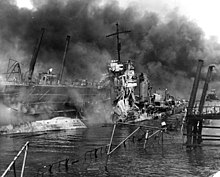
The wreck of the destroyer USS Shaw in the destroyed floating dock YFD-2

The burning Nevada on the way to the port exit
,_USS_Cassin_(DD-372)_and_USS_Pennsylvania_(BB-38)_in_Dry_Dock_No._1_at_the_Pearl_Harbor_Naval_Shipyard,_7_December_1941_(306533).jpg)
The wrecks of the destroyers Cassin and Downes off the Pennsylvania

A destroyed B-17 bomber at Hickam Field.
_burning_after_the_Japanese_attack_on_Pearl_Harbor_-_NARA_195617_-_Edit.jpg)
The burning Arizona: the front mast collapsed onto the bridge
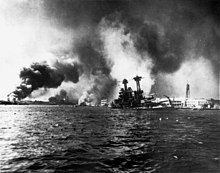
The sinking California
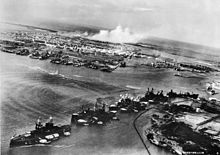
Battleship Row at the beginning of the attack. Oklahoma and West Virginia are already showing list, the West Virginia is just receiving a torpedo hit.
.jpg)
The destroyer USS Ward
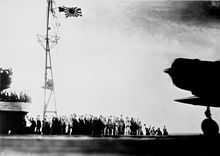
The crew of the Shōkaku bids farewell to an aircraft taking off with banzai calls

The two waves of Japanese attacks on 7 December 1941
Nagumo's decision to withdraw
According to the original plan, the first two waves of attacks would have been followed by at least one more to destroy the shipyard facilities and fuel tanks. The loss of these facilities and supplies would have massively limited operations by U.S. forces in the Pacific in the months that followed. Given the course of the war, many historians believe that eliminating Pearl Harbor as a naval base would have been a far more serious loss to the United States than the battleships it eliminated. Nevertheless, Admiral Nagumo decided not to launch the third wave, but to withdraw as soon as the attacking formations had returned. He cited the following reasons for his decision:
- Reports arriving from the first and second waves of attacks left no doubt that the battleships lying in Pearl Harbor had been devastatingly hit. Without these ships, the U.S. fleet, even with massive reinforcements from ships in the Atlantic, was not in a position to seriously impede the major Japanese offensive in Southeast Asia that was underway at the same time. The main strategic objective of the attack had thus been achieved.
- Preparing a third wave would have taken considerable time. The first wave's aircraft were brought below deck immediately after landing, since the flight decks had to be clear for the second wave's landing. It would have taken additional time to re-equip the aircraft with bombs and fuel, and then the aircraft had to be brought back to the flight deck for takeoff, at the same time moving the landed aircraft standing on the flight deck to the hangar deck. This complex and time-consuming process would have meant that the third wave would not have returned before nightfall. Night landings on carriers were not common in 1941; safe procedures for landing in darkness did not yet exist, and carrier aircraft were mostly not night-flight capable. A night landing would most likely have meant the loss of many experienced pilots that Japan could not spare. In addition, the ships would have been extremely vulnerable while the aircraft were being refitted. Six months later, the aircraft carriers Akagi, Sōryū, Hiryū, and Kaga were destroyed in the Battle ofMidway by a relatively weak attack that happened to occur during their launch preparations.
- The losses of the second wave had been twice as high as those of the first, because it attacked without the element of surprise. Another attack would fly against a fully defended enemy due to the pause of several hours and suffer even higher losses.
- As long as the planes were en route, Nagumo had to remain in position so they could find him to land. This, however, would give American forces the opportunity to counterattack with any remaining bombers as well as their submarines. Although the Japanese squadrons had approached the island from all directions as a deception, he had to expect that the Americans had noticed from which direction the planes were approaching and departing.
- The aircraft carriers were needed for the offensive in Southeast Asia. Many of the targets in Indonesia and New Guinea were beyond the range of land-based aircraft. He could not expose his formations (carriers and their aircraft) to great risk unless there was a compelling reason to do so. He felt that the destruction of the Pearl Harbor base was not sufficient to do so.
- The U.S. aircraft carriers were not at Pearl Harbor, and therefore there was a danger that they would suddenly encounter the Japanese fleet. If the Japanese aircraft were over Pearl Harbor at that time, the Japanese carriers would be almost defenseless against the attacks of the U.S. carrier aircraft.
Several staff officers as well as squadron commanders of the returned first attack wave pressed him to carry out the third attack anyway, but could not change his mind.
.jpg)
The submarine base with the fuel tanks next to it
Balance
Losses
There have been conflicting assessments of the immediate results of the attack. This is because smaller ships were often not counted or there were inconsistencies in the counting of damaged or destroyed ships. The dead and wounded were sometimes recorded separately by civilian, naval, and army affiliation; in some accounts, civilian casualties were not recorded at all.
So the following tally only approximates the destruction and casualties at Pearl Harbor.
Casualties on the US side
- 2403 Fallen
- 1178 wounded
- 18 ships had been sunk or - in some cases severely - damaged.
- 9 damaged ships
- 188 destroyed aircraft
- 159 damaged aircraft
Ultimately, all but three ships (the Arizona, the Oklahoma, and the Utah) of the sunk or badly damaged American units were recovered and returned to service before the end of World War II. Along with the Mississippi, five of the battleships sunk or damaged at Pearl Harbor (Maryland, West Virginia, Tennessee, California, and Pennsylvania) fought the Battle of Surigao Strait in 1944. In this last engagement between battleship fleets, fought by World War I battleships rather than the more modern Iowas and Yamatos, they sank the Japanese battleships Yamashiro and Fusō. The Nevada sailed for Normandy in 1944 as part of the Allied invasion fleet.
The worst loss for the U.S. was the deaths of the many innocent people. Of the 2403 dead, 2008 were Navy personnel, 109 Marine Corps, 218 Army. 78 civilians were among the dead. In addition, there were 1178 wounded. The Arizona, almost completely destroyed by the magazine explosion, is now a memorial; the wreck of the old battleship Utah, converted into an anti-aircraft training ship, was merely pulled into position where it would not be in the way. The last ship to be lifted was the capsized Oklahoma in 1943; the lengthy repair of her massive structural damage was no longer worthwhile at that point.
Medal of Honor awards
Fifteen soldiers were awarded the Medal of Honor, the highest award for valor in the U.S. Armed Forces, for their conduct during the attack, including 10 posthumously.
- Capt. Mervyn Sharp Bennion, commander of the battleship USS West Virginia (BB-48), posthumously.
- Lt. John William Finn, part of the repair force at Naval Air Station Kāneʻohe Bay.
- Ensign Francis Charles Flaherty, crewman of the battleship USS Oklahoma (BB-37), posthumously.
- Rear Admiral Samuel Glenn Fuqua, crew member of the battleship USS Arizona (BB-39).
- Chief Boatswain Edwin Joseph Hill, crewman of the battleship USS Nevada (BB-36), posthumously.
- Ensign Herbert Charpiot Jones, crewman of the battleship USS California (BB-44), posthumously.
- Rear Adm. Isaac Campbell Kidd, commander of the 1st Battleship Division, posthumously.
- Lieutenant Commander Jackson Charles Pharris, crew member of the battleship USS California (BB-44).
- Chief Radioman Thomas James Reeves, crewman of the battleship USS California (BB-44), posthumously.
- Captain Donald Kirby Ross, crew member of the battleship USS Nevada (BB-36).
- Machinist's Mate First Class Robert Raymond Scott, crewman of the battleship USS California (BB-44), posthumously.
- Chief Watertender Petar Herceg Tomich, crewman of the battleship USS Utah (BB-31), posthumously.
- Captain Franklin Van Valkenburgh, commander of the battleship USS Arizona (BB-39), posthumously.
- Seaman First Class James Richard Ward, crewman of the battleship USS Oklahoma (BB-37), posthumously.
- Captain Cassin Young, Commander of the Workshop Ship USS Vestal (AR-4)
Losses on the Japanese side
- about 65 pilots and submarine crewmen killed,
- about 29 aircraft destroyed,
- about 5 sunk two-man submarines,
- 1 prisoner (submarine commander Lieutenant Sakamaki Kazuo).
The low Japanese losses of only 29 aircraft exceeded even the most optimistic forecasts of the planners of the attack. Far higher losses had been expected. That these did not occur was due both to the complete surprise achieved and to the lack of combat readiness in which the American forces found themselves before the attack.
Strategic effects
Simultaneously with the attack on Pearl Harbor, the Japanese offensive in the Pacific began, Japanese troops invaded Thailand and landed in the Philippines. On the morning of December 10, Malayan time (barely 48 hours after the attack), Japanese bombers sank the Prince of Wales and the Repulse, battleships on the high seas and in full combat readiness for the first time in history. The sinking of these fast and modern ships by air forces alone ended the dominant role of the battleship in naval warfare up to that time.
With only one battleship left available, the non-Pearl Harbor Colorado, the U.S. Pacific Fleet no longer posed a threat, allowing Japan to deploy its entire fleet in Southeast Asia. Its now formidable naval and air superiority gave it the unrestricted initiative in the battle space, enabling the Japanese to overrun the nominally equally strong Allied ABDA forces (both sides had about eleven divisions of land forces in the battle area) within three months without much difficulty.
After the attack, the American Pacific Fleet was left only with defensive operations. Offensive operations were out of the question for a long time, since the Japanese fleet was now superior in every respect. It was possible to repair the lighter damaged battleships Maryland, Tennessee and Pennsylvania within three months in day and night work, so that together with the Colorado and the Idaho, Mississippi and New Mexico, which had been transferred back from the Atlantic, seven battleships were available again. However, this meant that they were clearly outgunned by the eleven Japanese battleships that had in the meantime been reinforced by the Yamato.
In the case of the aircraft carriers, the balance of power was even less favorable. Although no carriers were lost and reinforcements were provided by the Yorktown and Hornet, the five American carriers were opposed by eleven Japanese. Considerably more serious than the numerical inferiority was the qualitative difference in this now extremely important type of weapon. The Japanese had great experience in carrier operations, their crews were perfectly attuned, and their pilots had gained combat experience over China in the previous four years. On the American side, major carrier operations were nothing new, as they had practiced and evaluated attacks from aircraft carriers on the Panama Canal in prewar maneuvers. However, since U.S. carriers had been equipped with new aircraft types in the interim, they initially had problems coordinating activities on the flight deck. Six months later, when the carriers Enterprise and Hornet were to launch all aircraft for a joint attack in the Battle of Midway, it took too long after the first half of the aircraft had been launched to get the second half ready for takeoff. They were forced to abandon the joint attack and send the planes already launched off on their own before they blew too much fuel waiting. As a result, the units now attacking without fighter protection suffered heavy losses. More serious, however, was the lack of technical equipment, especially for fighters and the torpedo gun. The Grumman F4F was severely inferior to the Mitsubishi A6M in maneuverability, climb performance and speed, and it took until mid-1943 for suitable aircraft types (Grumman F6F and Vought F4U) to become available. However, new air combat tactics developed in the meantime by John S. "Jimmy" Thach enabled U.S. pilots to have real chances for aerial victories against the Japanese types even with the older aircraft. As for torpedo planes, the Douglas TBD was hopelessly outdated. Although it was replaced by the Grumman TBF after the Battle of Midway, the torpedoes themselves were slow and rarely worked. To save money, few tests had been conducted before the war, so no effective torpedoes were available until 1943. The performance of the Japanese Long Lance torpedo was never matched.
Since the surface fleet had no choice for the foreseeable future but to try to hold the position as best it could until reinforcements came from the shipyards in the form of new ships, the submarines became the only weapon with which offensive action could be taken against Japan. Chester W. Nimitz, one of the few admirals to emerge from the submarine force, was therefore appointed as the new commander of the Pacific Fleet. Subsequently, the American submarines waged a tonnage war against Japan, which depended on its sea links, that was so successful that today it is regarded by all sides as one of the main causes of the American victory in the Pacific.
At the time, the Japanese high command considered the battle a strategic success that exceeded its wildest expectations. The Japanese fleet had operated at the limit of its range, surprising the enemy to an extent hardly thought possible and eliminating its entire battle fleet in one fell swoop. In view of the unexpectedly low friendly losses of only 29 aircraft, the absence of the aircraft carriers and the sparing of the docks and oil depots appeared as minor blemishes in an otherwise incredibly perfect Japanese victory.
Today, however, the attack is considered a complete strategic failure on all counts. The fact that no aircraft carrier was sunk was still excusable, since the Japanese high command could neither foresee nor react to her absence when it was learned through the consulate that the Lexington had also sailed on 5 December. The attack could only be carried out on 7 December; the Japanese task force had no fuel reserves that would have allowed the attack to be postponed, much less to stop the entire offensive in Southeast Asia on short notice. Nagumo's failure to attack and destroy the base and its facilities, however, was very detrimental to the Japanese. The loss of the only docks in the Central Pacific would undoubtedly have hit the United States the hardest. That this was not done is evidence of a misplacement of priorities both by Nagumo himself and by the high command, which later considered the decision to call off the attack to be correct.
The extent to which the abort of the attack without a 3rd attack wave is to be seen as a misjudgement of the situation is controversial in some quarters. It is true that the destruction of the docks and fuel tanks would have considerably hindered the U.S. in its strategic planning and probably forced it to retreat to the U.S. west coast. However, this fact is offset by the fact that Japanese forces in the attack fleet had lacked the tactical means for successful attacks on a major naval base. Because of the composition of the carrier-based air forces available, it is highly likely that only an attack by dive bombers would have been an option, and these had already suffered some of the heaviest losses in the first two waves of attacks (14 dive bombers were lost and 41 damaged in the 2nd attack wave alone). The success of a 3rd attack wave must therefore be doubted, since the air defenses at Pearl Harbor had recovered quickly. Moreover, only arming the attack aircraft with 250-kilogram bombs would have been possible, making effective strikes even more difficult. The impact of carrier aircraft attacking a secured and prepared base was demonstrated a few months later in the attack on Midway.
The attack on the battleships is also often criticized: since they sank in shallow harbor water, they could nevertheless be raised and repaired relatively easily. If Japan, according to the original war plan (valid before the transfer of the fleet from San Diego to Pearl Harbor), had waited for the fleet to sail to reinforce the Philippines under attack and then sunk the battleships on the high seas, they would have been permanently lost. In addition, the sunk battleships proved unsuitable for the battleship's new role as an aircraft carrier escort because of their slow speed and mainly supported amphibious landings with their artillery during the war. Moreover, in addition to the loss of materiel, there would have been a much higher number of human casualties on the high seas that would have had to be replaced. The situation after Pearl Harbor, on the other hand, was different: many sailors and specialists were still available after the attack and were practically ready to fight. In addition to these considerations, there was another fact: The sinking of the older battleships ultimately left the U.S. with no other option but to concentrate on building aircraft carriers to stand up to the Japanese navy. In this way, Pearl Harbor accelerated the naval strategic paradigm shift. During the war, the U.S. commissioned 18 large fleet carriers and 77 escort carriers alone.
In conclusion, it must be stated in this context that the attack on Pearl Harbor - as serious as it may have been - was not only a strategic failure for the Empire of Japan, but actually already marked the path of the war's course. One of the biggest mistakes, in the eyes of some authors, was the fact that Japan entered the war with the U.S. and its potential without developing a precise strategy of how this conflict should lead to the desired result, and could not revise this negligence even in the following years of the war.
Political impact
The most serious consequence was the effect of the attack on public opinion in the USA: isolationism and pacifism lost their influence at a stroke. On December 8, the U.S. officially declared war on Japan; the declaration of war passed with only one dissenting vote in Congress, which had previously been divided between isolationists and interventionists. Four days later, Germany and Italy, who had also been surprised by the attack, declared war on the U.S., officially entering the European part of the war as well.
The surprise attack was considered underhanded and perfidious in the U.S. because it was carried out without a prior declaration of war (even the note delivered belatedly on December 7 contained only the breaking off of negotiations) and came as a complete surprise to the U.S. population. In the U.S., the term Pearl Harbor has since been used as a metaphor for a devastating, unprovoked, and unforeseen attack. December 7, 1941 is often referred to as the Day of Infamy![]() , after the opening of with which he sought congressional approval for the declaration of war the next day. The desire for revenge and victory over Japan led to a strong rush of volunteers to the recruiting offices of the armed forces. Japanese Americans were the first to feel the hatred; they were the victims of numerous attacks and were eventually imprisoned in internment camps. In 1988, President Ronald Reagan apologized on behalf of the U.S. government for this behavior based on "racism, prejudice, and war hysteria."
, after the opening of with which he sought congressional approval for the declaration of war the next day. The desire for revenge and victory over Japan led to a strong rush of volunteers to the recruiting offices of the armed forces. Japanese Americans were the first to feel the hatred; they were the victims of numerous attacks and were eventually imprisoned in internment camps. In 1988, President Ronald Reagan apologized on behalf of the U.S. government for this behavior based on "racism, prejudice, and war hysteria."
To investigate the attack, President Roosevelt appointed a commission of inquiry chaired by Constitutional Judge Owen Roberts. On January 28, 1942, the commission's report declared Admiral Kimmel and General Short to be primarily responsible for the defeat. They were accused of neglect of duty due to the lack of combat readiness of their forces. They had not taken warnings seriously enough, and Short in particular had made the airfields easy targets by his decision to park all aircraft in the center. Both commanders had already been relieved of their posts by mid-December 1941, automatically reverting from their previous 4-star ranks (but only temporarily awarded for their command) to 2-star ranks. Their careers were effectively ended. The view taken by the Roberts Commission was controversial from the beginning; many saw Kimmel and Short as scapegoats who would have been acquitted at any time if indicted by a military tribunal. In 1944, two commissions, one of the Army (Army Pearl Harbor Board) and one of the Navy (Navy Court of Inquiry), conducted another investigation of the attack (in all, after the Roberts Commission, seven investigations of the attack were conducted by 1946). In fact, the Navy Court of Inquiry found that Admiral Kimmel was not to blame; the readiness of the fleet was appropriate to the situation known to Admiral Kimmel. Particular emphasis was placed on the fact that the ships' anti-aircraft guns were ready for action and opened fire immediately when the attack began, while the Army's anti-aircraft guns sometimes waited hours for ammunition. General Short, on the other hand, was massively criticized for not anticipating the possibility of an attack and for not mentioning Pearl Harbor as a possible target in his war warning. The Army Pearl Harbor Board found that General Short was indeed guilty of dereliction of duty, but also criticized the Army leadership in Washington, particularly General Marshall. The Army leadership had also failed to recognize the possibility of an attack and had not corrected the Army's known low level of readiness in Hawaii, even though it anticipated imminent war with Japan. Both reports, however, were kept secret during the war, partly because several of the officers criticized now held high positions where they were doing work judged to be outstanding; their replacement was considered detrimental to the conduct of the war. Another reason was the role that the decoded Japanese radio messages had in the commissions' evaluation. The fact that the Japanese code could be read, however, had to remain secret during the still ongoing war.
Finally, on May 25, 1999, the Senate passed a resolution by a vote of 52 to 47 that cleared Kimmel and Short of all charges and posthumously elevated them to the 4-star rank that all other ranking U.S. officers of World War II had received no later than their retirement from the armed forces.
In Japan, the attack provoked mixed feelings. Admiral Yamamoto was appalled that the Japanese diplomatic note had been delivered only after the attack. This exacerbated what he saw as Japan's unpromising position to win the war from the start. He is said to have spent the day after Pearl Harbor sunk in depression while his staff celebrated. While there is no evidence that he ever uttered the famous phrase "I fear all we have accomplished is to awaken a sleeping giant and fill him with a terrible resolve." was ever said by him in the film Tora! Tora! Tora!" attributed to him. According to contemporary witnesses, however, the phrase accurately reflects Yamamoto's mood after the attack. The attack came as much as a surprise to the Japanese population as it did to the American, and although the Japanese government had been trying to create anti-American sentiment through propaganda for some time, many Japanese seem to have been horrified that they were now at war with the United States, a country that not a few Japanese admired. The Japanese, however, seem to have accepted the government's justification that the war was inevitable and subsequently supported the war policy until the Japanese surrender.

Franklin D. Roosevelt signs the declaration of war against Japan on December 8.

The Japanese conquests from 1937 to March 1942
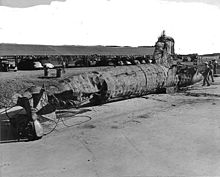
Wreck of Japanese small submarine
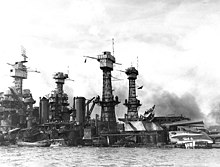
West Virginia (forward) and Tennessee heavily damaged aground
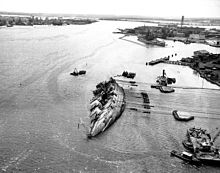
The Oklahoma is erected, March 1943
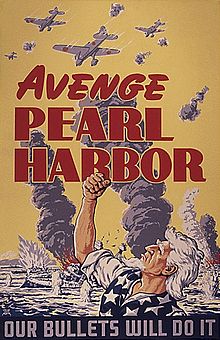
Propaganda poster: "Avenge Pearl Harbor".
Commemoration and symbolism
In 2016, 75 years after the attack on Pearl Harbor, U.S. President Barack Obama received Japanese Prime Minister Shinzō Abe at Pearl Harbor. Their meeting is seen as another step in reconciliation between the two countries, following President Obama's 2015 visit to Hiroshima.
See also
- Chronological course of the war in the Pacific
- Doolittle Raid
- Operation Vengeance
Movies
- The Battle of Hawaii and in the Malay Sea (Hawai mare oki kaisen) (1942)
- Damned for all eternity (1953)
- Banzai-Banzai, the Devil's Pilots (Hawai Middowei daikaikûsen: Taiheiyô no arashi, English dubbed title I Bombed Pearl Harbor) (1960).
- Tora! Tora! Tora! (1970)
- MacArthur - Hero of the Pacific (1977)
- The Last Countdown (1980)
- The Firestorm (1983)
- Pearl Harbor (2001)
- Attack on Pearl Harbor. Documentary, Germany (2006)
- JAG - On a mission of honor - The secret of Pearl Harbor (2000)
Questions and Answers
Q: What was the Attack on Pearl Harbor?
A: The Attack on Pearl Harbor was a surprise attack by Japan against the neutral United States naval base at Pearl Harbor, Hawaii on the morning of December 7, 1941.
Q: What was the purpose of the attack?
A: The Japanese military leadership wanted to gain time to invade Southeast Asia.
Q: How long did it last?
A: The attack lasted for seven hours.
Q: Which places were attacked by Japan during this operation?
A: Places governed by the US that were attacked included Philippines campaign (1941–1942), Guam, and Wake Island. Places in the British Empire that were attacked included Singapore, Hong Kong and Malaya.
Q: What other names did Japan refer to this operation as?
A: Japan referred to this operation as the Hawaii Operation, Operation AI, and as Operation Z.
Q: How did this attack lead to World War II?
A: This attack led to United States entering World War II.
Search within the encyclopedia